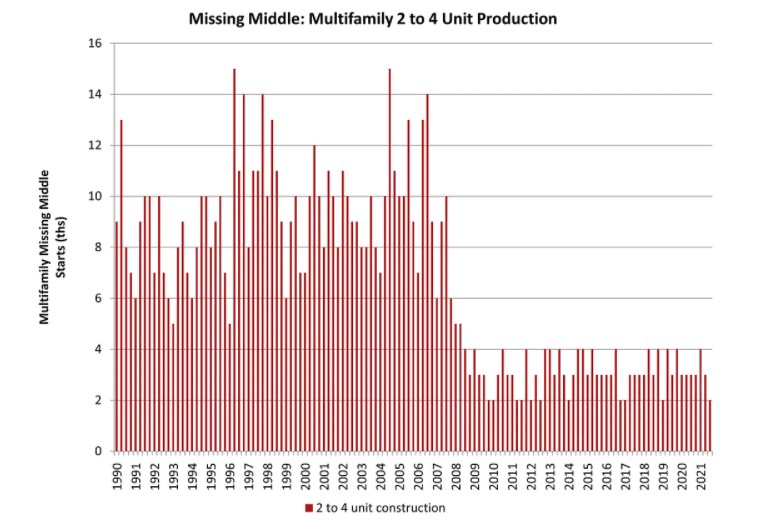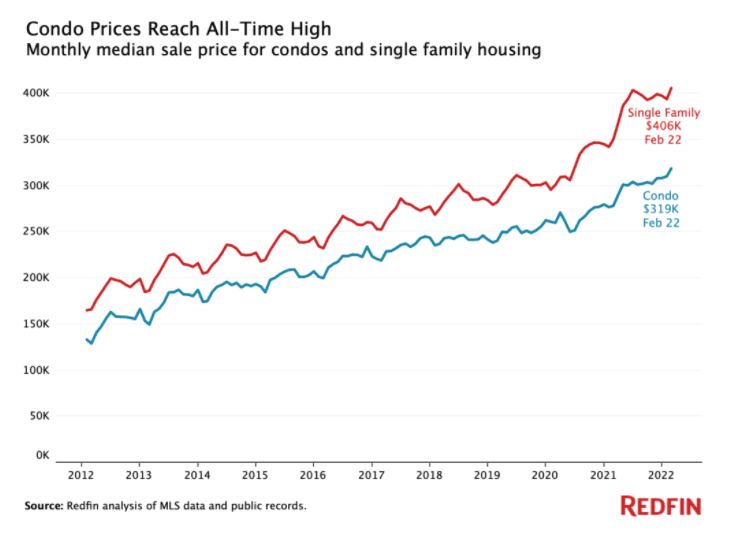In this week’s issue, we explore the various discussions around missing middle multifamily.
This Week’s Top Headlines
We start off with the week’s top multifamily stories:
- The downside of bad access control: A 450-apartment NYC skyscraper described as ‘high-rise hell’ — NYT
- Multifamily lending is expected to hit $1 trillion this year, up 13% from 2021 — MHN
- New data shows that multifamily rent growth in 2022 is outpacing that of 2021 — Globe St
- Multifamily mortgage delinquency rates declined in Q4 2021, and were either flat or fell for every major investor group at the end of 2021 — RIS Media
- New MBA data shows that the level of commercial/multifamily mortgage debt outstanding during Q4 of 2021 was $287 billion, 7.4% percent higher than Q4 2020 — MBA
- Multifamily property prices rose an astounding 23.2% in February year-over-year, the highest rate on record (since recording began in 2000) — Yield Pro
- Developer Alterra is offering tokenized shares in a 24-story Silicon Valley housing project — Globe St
The Story
Missing middle describes pre-WWII housing that includes duplexes, triplexes, rowhomes, courtyard apartments, small multifamily, and denser types of living that fit within a low-rise community. And there is a dire need for more of it as we explore ways to introduce gentle densification and affordability into our cities and towns.
We simply haven’t built enough of this asset type, in favor of suburban sprawl and high-rise condos. According to recent NAHB data, missing middle multifamily has shown weakness, with Q3 2021 starts totaling 12,000 year-over-year, down about 8%.
Where there’s neglect in the market, there’s opportunity. With land, labor, and material costs all going up, according to CNU, many multifamily developers are looking for other asset types to build beyond single-family suburb homes and high-rise condos. This is why many are looking to integrate more missing middle into their portfolios.
There are some headwinds to missing middle development: minimum lot sizes, exclusionary R1 zoning, parking requirements, height restrictions, NIMBYism, among others. That said, governments are wising up to the benefits of enabling gentle densification with missing middle housing, and this trend looks to continue for the foreseeable future.
Missing Middle Examples
- Oregon — Portland upzoned most of its city allowing for 2-4 units on what were previously single-family lots. Planners now estimate that this will add 4,000 new units over the next 15 years.
- California — SB9 was passed last year in the state allowing for almost all R1 zoned lots to now, by legal right, have up to 4 units on them under certain guidelines. That is, a single-family home can now be converted into a triplex for instance without having to go through time consuming and expensive rezoning applications.
- New Hampshire — The state legislature is debating a bill that would allow, by right, single-family homes and lots to subdivide up to four units. This basically overrides existing single-family zoning in what is typically called ‘inclusionary zoning’.
Of note, allowing missing middle means less demolition as developers typically seek to upgrade existing structures to their highest and best use rather than tearing them down. Further, it lends itself to the more environmentally-friendly building methods such as modular construction.
Expert Take
“It is about reframing the conversation to cover the kind of community its members want and how can we build that kind of community. Oftentimes we’ll ask, “Well, do you want to be able to walk to something? Do you want to be able to have a café? Do you want to be able to have a small grocery store?” That means we need enough feet on the street to be able to support that grocery store, and you can’t make that work with detached single-family homes. So you need reframe that conversation. “Well, how do we actually make that happen?” In these types of conversations, missing middle housing is a key ingredient to making those visions for what they want work.” — Karen Parolek, CNU
So What?
As state and local governments look to tackle housing supply and affordability in the coming years, particularly as borrowing costs rise, look for more opportunities to develop missing middle housing. Upzoning will mean these projects will be much more affordable and streamlined than ever before.
Weekly Chart: People Want Condos
According to Redfin, the average sale price of a U.S. condo hit a record of $319,000 in February, up 14.6% year-over-year, and 22.7% from two years earlier.



